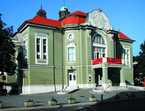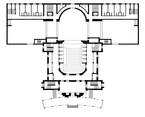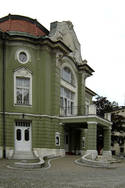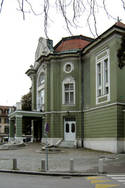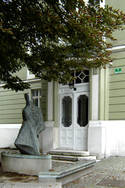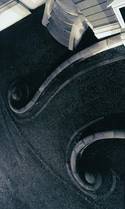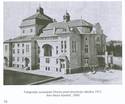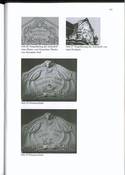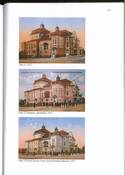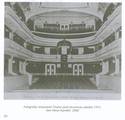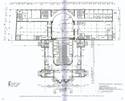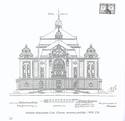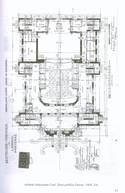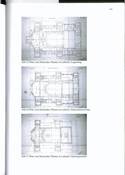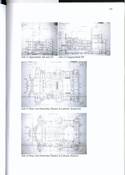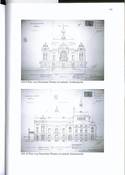The Slovene National Theatre Drama, Ljubljana
Alexander Graf
alias Royal National Theatre in Ljubljana (1920 - 1941), Deutsches Theater (1911 - 1919), Drama of the Slovene National Theatre in Ljubljana (after the WW II), Kaiser Franz Joseph Jubiläumstheater (1911 - 1919), National Theatre in Ljubljana – Drama (1919 - 1920), State Theatre Ljubljana (during the WWII)Erjavčeva ulica 11, | |
| show on the map | http://www.drama.si/ |
Important events
Plans were created by the Vienna architect Alexander Graf, former coworker at Vienna arcitectural desing studio Fellner & Helmer.
The first performance in Slovene language was Tugomer by Josip Jurčič and Fran Levstik. Since then, the building has been used exclusively for the staging of theatre performances in Slovene language.
The theatre acquired the name National Theatre in Ljubljana – Drama.
People
A co-worker of the atelier Fellner and Helmer. He employed the proven Renaissance-Baroque style as was usual in the atelier Fellner and Helmer in most of the small city theatres he built in various parts of the monarchy. By the other buildings, he did not take great delight in experimenting as the buildings have the form of the Italian or German Renaissance and are ornamented with Baroque motifs.
More theatresHistory
Even before the mid-17th century, there stood a building next to the gardens belonging to the Turjak counts and the end of Igriška ulica, which is the location of the present-day building of the SNT Drama Ljubljana. This can be seen on depictions of Ljubljana from the collection of Janez Vajkard Valvasor from around 1680. In 1743, Daniel Erberg sold the building to the Carniolan authorities, whereupon it was enlarged and dedicated to sports and dance. The building was called Balovž in Slovene, or Ballhaus in German, and parties and ball games were held in it, whilst the aristocratic youth had their language, dancing, horse riding and fencing lessons there. When a public dance hall was built in the former Jesuit grammar school on Šentjakobski trg, Balovž was abandoned and after 1781 used as a granary. The former appearance of the building is documented in the plans dating from 1815, now kept by the Archive of the Republic of Slovenia. The building stood on a rectangular ground plan, had three levels and was covered with a steep hipped roof. The entire interior was in the 19th century used as a granary, serving the upper classes. This is why the building had small, horizontal rectangular windows, apart from on the eastern façade, where there were slightly larger rectangular windows. The building was damaged during the 1895 earthquake and demolished soon afterwards, together with three neighbouring buildings. The ground was then levelled for a square. The only reminder of the former “igrišče” (Slovene word for playground) is the name of the neighbouring street Igriška ulica.
However, the location of the former Balovž did not remain empty for long. After the construction of the Carniolan Provincial Theatre which in 1892 replaced the theatre that had burnt down in 1887, the German inhabitants of Ljubljana were not happy about having to share the space used for performances and rehearsals with Slovenes. So they began to plan for their own theatre. In 1894, united in the society Deutscher Theaterverein Laibach, with thehelp of the Carniolan Savings Bank, they established a special fund for the new theatre and in 1907 a committee was appointed to be in charge of the building project. The planning and organisation were good. Even Emperor Franz Joseph contributed 20,000 krona in February 1909. The society followed a common practice, well known throughout the Austro-Hungarian monarchy, of naming something after an emperor and celebrating his or her birthday or anniversary in order to obtain additional funds. The new theatre was thus officially named Kaiser Franz Joseph Jubiläumstheater (The Anniversary Theatre of Emperor Franz Joseph), but it was also known under the name of Deutsches Theater (German Theatre). The plans for the building were drawn up by the Vienna architect Alexander Graf (1856–1931), formerly a member of the famous architectural studio Fellner and Helmer, that specialised in theatre buildings. Graf had a sufficiently eminent name whilst being suitably conservative. Implementation plans are kept in the Historical Archive in Ljubljana; the oldest plans are dated 31 August 1909 and the final ones were approved in August 1912. Graf designed the building in a simple and transparent manner, on the basis of his slightly adapted plan for the theatre in the town Ústí nad Labem in the present day Czech Republic, built in 1909. He also used as a base his plans for two other theatres in the then Bohemia: in Ostrava, dated 1907, and in Most, dated 1911. Thus the Ljubljana building was serially produced architecture with numerous already established details and basic designs, typical of the Fellner and Helmer school. The basic form of the building was Neo-Baroque, also a reminder of the flourishing of the monarchy during the reign of the Empress Maria Teresa. However, there were also some Secession elements.
The building was designed as an independently standing dominant architectural unit with a varied structure, including on the southern side a projecting stage tower. The design was completely subjected to the central axis along which the stage, the auditorium and a porch with a balcony above were positioned in sequence. The exterior was marked by a combination of angular and curved shapes. This effect was additionally strengthened by the steep tiled roofs interspersed with garrets. The roofs above the auditorium and the stage acquired airing towers with lantern roofs. The ground floor of the entire building was structured with rustication elements in the plaster, whilst the plaster in the upper floors was smooth. The exterior was originally painted green. In addition to the main entrance, the building had another three entrances on both sides, placed in stair turrets. The exterior thus indicated the arrangement and division of the interior. The architect, understandably, focused most on the main façade, where the upper part of the building is split with a broad window finished in a semi-circle and above it there is a volute-like gable with a large cartouche in Secessionist style; originally this held, in addition to the symbols of the theatrical art, the inscription Kaiser Franz Joseph Jubiläums Theater. The main entrance was emphasised by a balcony on two pillars and a double sloping driveway with edging stones finishing with a volute. The front façade ends on both sides with tower risalits containing staircases. Later alterations partially obscured this design; only the front half of the building retains an unaltered appearance. Initially, the theatre building together with the neighbouring German House formed a single unit; the later alterations completely undermined this connection.
The original design is better visible inside. The main entrance leads to the entrance hall, which is designed in a fairly utilitarian fashion, next comes a corridor, from where two doors lead to the stalls. In the stalls, there were originally 162 seats in eleven rows. At the back, below the balcony, the stalls were divided, with the back section intended as standing room for 120 people. On the first floor, the stalls were surrounded by the most prestigious boxes. Opposite the stage was the central, slightly wider imperial box. On the second floor there was a gallery for less demanding visitors and with standing room for students. At the theatre opening, the auditorium had room for an audience of 657; it was 18 metres long, up to 12 metres wide and up to 12 metres high. The stage was 14.5 metres long and 9 metres wide. The design of the auditorium was marked most strongly by the contrast between the dark red velvet, gilded stucco ornamentation and white entrances and box railings. Initially the central artistic emphasis was on the main stage curtain, which was decorated with a painted idealised view of Ljubljana from the castle hill. The curtain was removed before the Second World War as it was so worn. Graf also paid particular attention to fire safety. This is why there were six side exits and a special room for firefighting equipment. The building had running water, electric lighting, central heating and a ventilation system. The foundations were of concrete, the walls of brick, and the ceiling construction, stairs, the gallery and box structure, and the proscenium bridge of reinforced concrete. The walls dividing the boxes and the auditorium ceiling were made of reinforced plaster. The stage could be separated from the auditorium with a metal screen that could be raised. The total cost of the construction and all the interior equipment and furnishing amounted to 673,964 krona. The construction work began in October 1910. Most of the work was carried out by the building firm Kranjska stavbinska družba and a smaller part by the Vienna firm Janesch & Schnell. The opening took place on 4 October 1911 with Wagner’s Kaiser March, a festive speech and the performance of the play Habsburg, written by Baron Alfred Berger.
The German Theatre remained active until 2 January 1919, when due to the conflicts between Austrians and Slovenes in Carinthia German theatre performances were abolished. The building remained under the management of the German Theatre Society until 16 January 1919, when it was transferred, together with everything in the building, to the use of the Slovene Theatre Consortium. On 6 February 1919, the first performance in the Slovene language took place: Tugomer by Josip Jurčič and Fran Levstik. Since then, the building has been used exclusively for the staging of theatre performances in Slovene. The theatre acquired the name National Theatre in Ljubljana – Drama. The old inscription in the stucco cartouche on the main façade was replaced with a new large inscription that says DRAMA. In 1920 the theatre was renamed as the Royal National Theatre in Ljubljana. The development of theatre activities in this building between the two World Wars influenced the production of various renovation proposals which were, however, never realised. In 1934, the architect Emil Navinšek produced plans for the alteration of the exterior, now kept in the Slovenian National Theatre Museum, according to which the German Neo-Baroque character was to be replaced by a Modernist-Classicist appearance. Engineer Božidar Čulk created plans for the renovation of the stage and for the extension on the western side of the building, whilst architect Vladimir Šubic drew up a plan for the surroundings. During the Second World War Bojan Stupica produced plans for the alteration and renovation of the building.
During the Second World War the theatre was renamed again, this time as the State Theatre Ljubljana, and after the War as Drama of the Slovene National Theatre in Ljubljana. The development of theatrical activities after the War influenced the design of the building. Soon after the War, busts of Slovene dramatists and actors began to be put in the entrance hall and the foyer. In 1946, the ante-room of the boxes was partitioned off, thus closing the corridor running at the back of the boxes. At the same time a few auxiliary rooms were created. In 1952, the stage was partly altered by increasing its depth and height. At that time, plans created by the architect Josip Černivec were published in the theatre’s regular publication Gledališki list Drame, which envisaged the building of two transversal extensions next to the stage, housing auxiliary premises. The plans included a complete renovation of the exterior, which would mean that the exterior structure would be lost completely, replaced by a new Modernist appearance with very modest structuring. The whole would thus acquire a serious and, in comparison to the existing design, boring character. These plans were not realised, but between 1960 and 1961 the architect Dušan Medved produced another set of renovation and extension plans, which in terms of the new extensions took note of the basic characteristics of Černivec’s ideas. In 1960, the auditorium was thus renovated and the standing section was filled with seats. At the same time the student standing room on the gallery and the already greatly altered imperial box were removed. Between 1964 and 1967 two large, functionally designed extensions were added at the two lateral sides of the stage tower, thus creating a massive transversal section at the back of the building. This provided for additional room backstage, a small stage, storage room for sets, dressing rooms and administration offices. The building work was supervised and pushed forward by the then director of the theatre Bojan Štih, but in spite of all the efforts, the new sections were never completely finished. The building thus obtained valuable new functional surfaces whilst losing a part of its historical design and the connection with the neighbouring German House, with which it used to form a whole. The new extensions altered the urbanistic role of the building and tied it to the street system; since then, the building extends all the way to Igriška ulica and on the eastern side opens to Slovenska cesta with an open colonnade. The square building volume of the new transversal wing tried to resolve issues connected with the basic function of the building following the method of contrasting additions, but at the same time it devalued the easy graduation of the building structure. Due to the construction of new sections, the south stair turrets and the side facades up to the central staircases were removed. The Neo-Baroque structured roof above the stage section was removed, the stage was lengthened semi-circularly towards the south and two staircases with two flights of stairs were added. The new components were, to a large extent, designed in a utilitarian fashion and took into account mainly the theatre’s functional requirements. The construction of the planned new entrance extension on the northern side, designed as a cubic building mass with aluminium and glass elements, never materialised and thus the picturesque Neo-Baroque graduation of the building structure has been preserved at least on the most prominent part of the building.
Between 1978 and 1979, following plans by the architect and set-designer Mirko Lipužič, the interior of the auditorium was renovated and new seats for 500 people installed. The colour scheme of the auditorium was also changed, but the gilded ornamentation was preserved. In 1987, the exterior of the older part of the building was renovated and on the basis of probing and comparative analyses the green colour of the frontages was restored. The extensions preserved the ochre coloured plaster.
In recent years, there has been discussion of an ambitious plan for a thorough renovation and enlargement. In 1996, the architect Majda Planišček, in cooperation with the architect and set-designer Meta Hočevar, created an ambitious proposal which envisaged the widening of the building, particularly of the sections below ground. Thus the building would be enlarged with a hall containing 180 seats, a café and auxiliary premises. The proposal included the enlargement of the extensions next to the stage. None of this was realised and by July 2008 new plans emerged on the basis of the proposal, created by the architects Andrej Nolda and Rok Gerbec, based also on the solution that received the first award in the public competition held in 2000. According to these plans, the theatre would be enlarged with two new underground halls, the smaller one seating 170, and the experimental stage hall 120. New rehearsal space would also be added, as would space for reading, singing and ballet rehearsals, and more comfortable foyers and dressing rooms for actors. According to these, the total surface area of the building would increase from 5000 to 12,000 square metres. Most of the additional space would be below ground. At the same time, the Neo-Baroque roof of the stage tower would be removed and the height of the tower increased, whilst the existing two extensions by the stage would also be altered and enlarged. So far, these plans have not been realised.
Sources and literature
Sandra Horvat, Das Kaiser Franz Joseph-Jubiläumstheater in Laibach. 1911–1918. Diplomarbeit zur Erlangung des Magistragrades der Philosophie an der Philologisch-Kulturwissenschaftlichen Fakultät der Universität Wien, Wien 2006
Darinka Kladnik, Ljubljanske metamorfoze, Ljubljana 1991, pp. 104–105
France Koblar, Dvajset let slovenske drame. I. 1919–1930, Ljubljana 1964
Silvester Kopriva, Ljubljana skozi čas, Ljubljana 1989, pp. 121–122
Walter Lukan, Pozdrav iz Ljubljane. Mesto na starih razglednicah, Ljubljana 1986, p. 77
Mirko Mahnič, Temelji slovenskega gledališča. Katalog razstave Slovenskega gledališkega muzeja, Ljubljana 1967
Mirko Mahnič, Prispevek k podobi Narodnega gledališča v Ljubljani od 1920 do 1924, Dokumenti Slovenskega gledališkega muzeja, 17, 1971 (z objavljeno fotografijo: Bojan Stupica z maketo nove Drame leta 1944)
Breda Mihelič, Vodnik po Ljubljani, Ljubljana 1989, p. 84
Dušan Moravec, Delo Bojana Stupice v slovenskih gledališčih, Dokumenti slovenskega gledališkega muzeja, 17, Ljubljana 1971, p. 29
Julius Ritter Ohm Januschowsky, Das Kaiser Franz Joseph Jubiläums Theater in Laibach, Denkschrift aus Anlass seiner Eröffnung am 4. Oktober 1911, Laibach 1911
Ivan Stopar, Sprehodi po stari Ljubljani, Ljubljana 1992, p. 196
Nace Šumi, Arhitektura secesijske dobe v Ljubljani, Ljubljana 1954, p. 40
Savo Volovšek, Elaborat gradbene in prostorske akustike za objekt adaptacija SNG Drama v Ljubljani, Ljubljana 1997 (Zavod za gradbeništvo Slovenije)
Gojko Zupan, Drama prostora in stavbarjev, Dokumenti Slovenskega gledališkega muzeja, št. 74/75, letnik 36, Ljubljana 2000, pp. 5–63
The Historical Archive in Ljubljana keeps the plans created by Alexander Graf for the building of the theatre and various documents relating to the construction (sig-489).
Author: Igor Sapač
Igor Sapač:
The Miners’ Theatre in Idrija, The Tartini Theatre, Ptuj Town Theatre, Slovene People's Theatre Celje, The Slovene National Theatre Drama, Ljubljana, The Koper Theatre, The Slovene National Theatre Maribor, The Slovene National Theatre Opera and Ballet Ljubljana, The Prešeren Theatre, Kranj, Maribor Puppet Theatre, Ljubljana Puppet Theatre and Šentjakob Theatre, The Estates Theatre in LjubljanaTranslator: Maja Visenjak Limon
Maja Visenjak Limon:
The Miners’ Theatre in Idrija, The Tartini Theatre, Ptuj Town Theatre, Slovene People's Theatre Celje, The Slovene National Theatre Drama, Ljubljana, The Koper Theatre, The Slovene National Theatre Maribor, The Slovene National Theatre Opera and Ballet Ljubljana, The Prešeren Theatre, Kranj, Maribor Puppet Theatre, The Slovene National Theatre Nova Gorica, Ljubljana Puppet Theatre and Šentjakob Theatre, The Estates Theatre in Ljubljana, Trieste Permanent Slovene Theatre, The Old Power Station, The Mladinsko TheatreAdditional information
No information has yet been entered
Add information


